THE VILLAGERS OF COLLINGHAM AND LINTON WHO SERVED IN WORLD WAR ONE
COLLINGHAMANDDISTRICTWARARCHIVE.INFO
 CONTACT
CONTACT


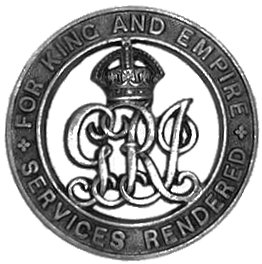
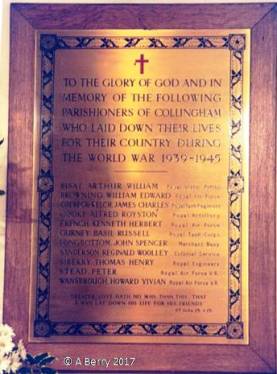
Rank 2nd Lieutenant
Service Army
Battalion 7th Battalion
Regiment East Surrey Regiment
Died: 26th July 1940
Buried Dungloe, Eire
| Rank | Number | Unit |
| Private | 6522 | 28 London Regiment |
| Private | 761380 | 28 London Regiment |
Trade or Occupation pre-war: Student
Marital status: Single
* Taken from attestation papers or 1911 census
** Marital status on enlistment or at start of war
- Named on war village memorials or Roll of Honour
Biography
Family background
Reginald Wooley Sanderson was born on the 5th January 1897 in Garforth, Yorkshire but by the census date in 1911 he was living at 11 Grange Avenue, Chapeltown Road, Leeds. At some time his parents, Henry and Edith moved to Fairlea, Collingham.
Reginald served in the First World war but survived, albeit injured and being invalided out of the army. However Reginald's name is on the village war memorials, on the Second World War village memorial in St. Oswald's Church, having been killed in 1940.
Reginald was educated at Leeds Grammar School and Christ Church, Oxford.
Service record
He first attested in WW1 as a private in the 28th London Regiment (Artists Rifles) on the 6th December 1915. His regimental number was initially 6522, but later changed to 761380. On the 10th January 1916 Reginald transferred, at his own request, to the 2nd Battalion London Regiment. His record suggests that he first went to France on the 3rd March 1916, embarking in Southampton and disembarking on the 5th at Rouen, and a day later was transferred to the 1st Battalion. His record shows he joined the battalion in St.Omer on the 24th March 1916. He served in France for about 17 months. On the 17th July 1917, Reginald applied for a commission which was granted on the 2nd August 1917 and Reginald was commissioned and posted as a 2nd Lieutenant to the 7th Battalion East Surrey Regiment. It seems that Reginald was granted some leave in the UK starting on the 22nd August 1917, but his record does not say how many days leave he had.
From the 2nd to the 6th August, the 7th East Surrey Regiment were manning the trenches in defence of Monchy, just south east of Arras. If Reginald joined them in those days he would have had a few days in the front line before they moved (on the 6th) into reserve, although they did take part in some raids on enemy trenches. These were designed to harass the enemy and keep them on their toes, while also capturing a few prisoners to gain intelligence from them. The battalion also formed working parties during those days, before a bigger withdrawal for a couple of days rest nearer to Arras (at Tilloy) on the 11th and 12th August.
On the 12th, the battalion returned to the Brown Line, but these were quiet days for the battalion, working at night to maintain and reinforce defences. For the next few days the battalion spent some days in reserve and some in the front line. On the 26th, the battalion moved to Arras for 8 days training and rest. The men had a chance to bathe, and kit inspections were carried out, along with drill and company training and practice for the Lewis guns on the range.
On the 2nd September the battalion left Arras as 8pm by train and relieved the 5th Royal West Kent Battalion in support trenches (Spade Trench, Strongpoints and Les Posse Cave), the relief being complete by 10.30pm. We guess that Reginald Sanderson would have rejoined the battalion by this time, but the war diary does not mention when he joined. From the 3rd Sept the battalion was in a quiet section. They formed working and ration parties at night, but there was little to report in the war diary during the week, until they were relieved on the 10th and moved back to the Brown Line. These spells in the Brown Line were still busy days for the battalion and every night the men formed working parties. On the 19th, they returned to the front line - this was a busier time. The War Diary explains:
21.9.17 TM fire was much heavier - our support line suffered - mostly from 4.5" Howitzer fire and Medium TMs.
22.9.17 The brigade on our left raided LONG trench at 2.30pm. The raid was very successful - some prisoners being brought back. Most of the return barrage came down on our line and the line of the battalion on our left. Our casualties were only 2, owing mainly to the bad shooting of the enemy.
23.9.17 Casualties were heavier today and everything pointed to the enemy preparing an attack or raid. Our wire at our point was much blown about.
Later on the 23rd the battalion moved back to support, and it was not until 2 days later that the expected enemy raid took place, but it did not pierce the British front line. The month ended with the Battalion withdrawing again to Arras for rest. These days allowed for training for the men, for example in raiding techniques, as well as providing much needed opportunities to get away from the horrors of the front line. The war diary records that on the afternoon of the 2nd October an East Surrey Officers team played the Royal Berkshire Officers at cricket, with the Royal Berks winning by 9 runs "after a good game", and that a concert was arranged for the battalion on the 4th October.
The battalion returned to the lines again in October and followed the same pattern of days in the front line, raids, and time in support repairing trenches. On the 24th October the battalion marched back to Tilloy and then travelled in lorries to Beaudricourt for rest and recuperation. After a few days the battalion moved to more serious training with time on the ranges and then practice attacks supported by tanks, although the diary noted that the tanks were replaced in these mock attacks by flag men. On the 7th November the battalion carried out further practice attacks with tanks on the Eclimeux training ground, before returning to Bonnieres where they undertook further practice raids. This was clearly the prelude to an attack and the preliminary, but very detailed, orders for this were issued on the 14th November. This attack is now known as The Battle of Cambrai (1917) (See Map 1). The objective of the attack involving the 7th East Surrey Battalion was to break the enemy's line by a coup de main between the CANAL DE L'ESCAUT at BANTEUX and the CANAL DU NORD near HAVRINCOURT, and to pass the Cavalry Corps through the gap on the first day.
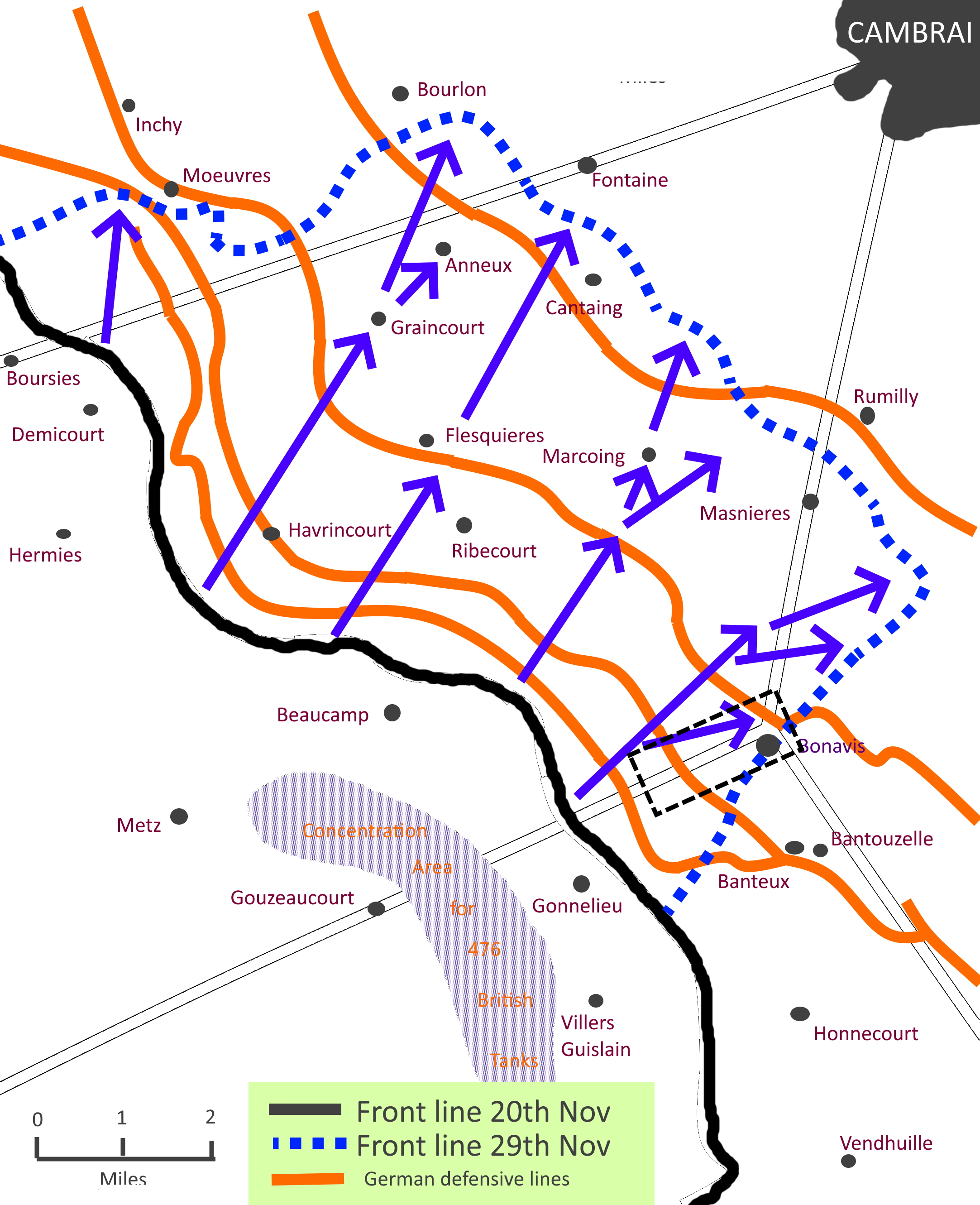
Map 1: The area covered by the Battle of the Cambrai (click for full size). The approximate area of fighting of the 7th East Surrey Regiment on the 20th November 1917 is shown in the dashed box. This corresponds to the sketch map from the war diary shown in Map 2.
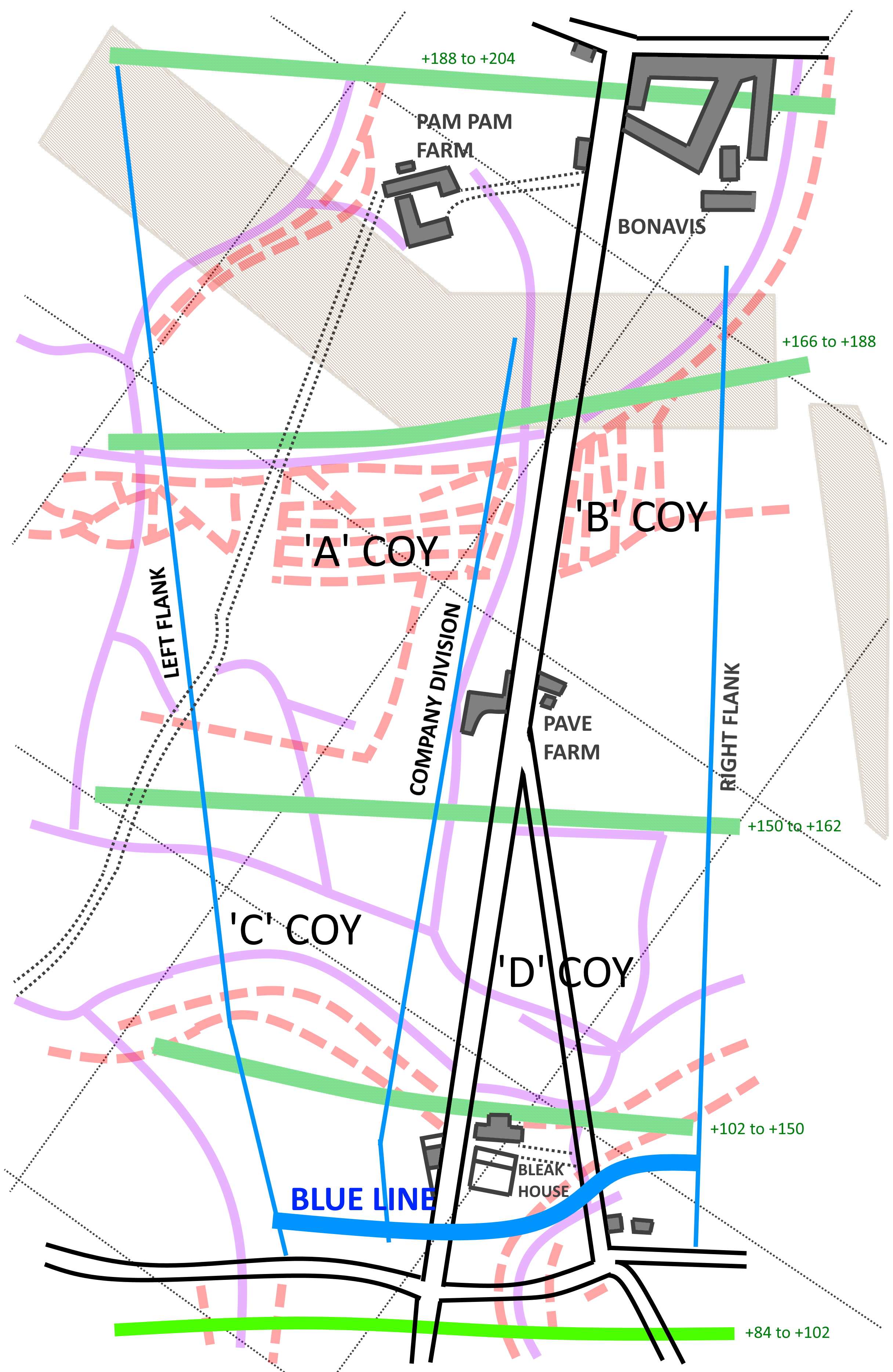
Map 2: The approximate area of fighting of the 7th East Surrey Regiment on the 20th November 1917 shown in a sketch map from the war diary. Green lines show the artillery barrage lines and the times at which these were to be attacked. Purple lines mark the positions of trenches. Enemy wire is shown by red dotted lines. Grey shaded areas near the top and at the right indicate areas which were to be targeted by smoke.
The story of 7th Battalion East Surrey Regiment in this battle is best told by its War Diary:
| 15 Nov | The Battalion prepared to move on the 16th inst. and during the morning carried out Brigade practice on the taped course. |
| 16 Nov | The Battalion moved by rail from BOUQUEMAISON to PERONNE where it detrained (about 7pm) and marched at 8am to HAUTE ALLINES. |
| 17 Nov | The Battalion moved to HEUDECOURT - a distance of about 8 and a half miles over bad roads and at night, arriving at HEUDECOURT about 9pm. | 18 Nov | Stores were issued today. Final orders were issued today with regard to the attack. At 5pm Company Commanders and the Adjutant went by a taped route to the Brigade assembly positions behind GONNELIEU. The route was bad and the night dark but we eventually managed to find our way. There was no activity on the part of the enemy and it seemed then as if our coming attack would be a surprise. |
| 19 Nov | A day of comparative quiet. Final stores were issued. At 11.35pm the Battalion moved off to its assembly positions arriving there about 3.30am. The men got tea there and drew Lewis Guns etc. The Colonel and the Adjutant visited Brigade HQ and there was a general wishing of good luck. |
| 20/11/17 The Attack |
At 6.20am the Zero barrage opened and tanks could be seen crawling over the ridge in the 'half light'. There was no enemy retaliation at the spot where the Brigade was, as we were only 1800 yards from the German line, luck was with us. At 6.50 am, the Battalion moved off by platoons round the road encircling GONNELIEU to the North. Enemy shrapnel was bursting on the road exit from the village. The front line lies almost on the edge of GONNELIEU and in a very short time the leading platoons were in "No Man's land". The hostile barrage was fairly heavy all about this area, especially in the sunken LA VACQUERIE Road. This road was therefore avoided. The Battalion gradually shook out into Artillery Formation after leaving the village, and in company with Tanks and enemy bullets and shells, moved on towards the BLUE LINE. Two companies on either side of the main BONAVIS-GOUZEACOURT Road. German machine guns and snipers were still firing from SONNET FARM, although the troops who were taking the first system were well beyond. This was the case throughout the attack and was due to the difficulty of clearing or mopping up in time to keep pace with the advancing troops. Captain D.F. Roberts was unfortunately killed near SONNET FARM, by a bullet through the head. The two companies on the left slightly lost direction owing to their following the line of a valley and losing sight of the main road which was our line of advance. On arrival at the BLUE LINE some houses on the right which should have been taken were still holding out and our right two sections of tanks were a little late. The Battalion was due to advance to the attack from the Blue line at 8.50am. At 9am 'C' and 'A' Companies advanced to the attack with two tanks, and at 9.8am the tanks having got into position, and the houses on the right having been cleaned up, the attack on the right was continued. The attack all the way was made difficult by heavy rifle and machine gun fire and the men effective rushed position after position by means of short pushes and rifle fire. The wire presented no difficulties and the tanks polled on and over in a very sedate fashion. Often during the attack it was possible to talk to the officer in the tank and get him to deal with any difficult point that presented itself. This liaison was excellent and considerably helped in the clearing up of machine gun positions. On the left, the leading company, 'C' Company, gained its objective and captured many enemy (about 80 to 100 being reported). A Colonel and his Adjutant and full staff, after some difficulty were enticed out of a dug-out by 2/Lieut Jordan. About 9 machine guns were taken here. 'A' Company then went through 'C' Company and advanced to their objective, The Hindenburg Support Line. Machine gun fire was met with from a German Signal Station halfway. When pushed by 'A' Company they cleared out with their guns and made back to the Hindenburg Support Line. 'A' Company gained their objective, but Captain S.F. Ayres was killed in the German wire by a bullet from the above machine gun. The gun and crew were afterwards captured and both 'C' and 'A' Companies set to work consolidating. On the right, the attack was somewhat delayed, owing, as I have said before, to the temporary absence of tanks and opposition that had not been taken. A defensive flank to join up with the Companies advancing on the left was thrown out. This was made up by men from Battalion Headquarters. At 9.10am the tanks charged the houses that were holding out, and then polled on to the attack followed by 'D' Company, and with 'B' Company behind together with some of the 6th Buffs, who were close on the tail of the Battalion. Bleak House Brickfields offered little resistance and 'D' Company with 2/Lieut Willcox at the head charged a battery position a little further on and captured 4 guns and about 70 prisoners. One platoon of 'B' Company under 2/Lieut E.A. Kemp then passed through. With them came some 6th Buffs and not long afterwards Major L.D. Scott, MC. PAVE FARM was captured and a mixture of 6th Buffs and 'B' Company pushed and took their final objective in the Hindenburg Support Line. 2/Lieut R.W. Sanderson and 99 other ranks wounded; 6 other ranks missing. Officers who took part in the attack were as follows: Lieut. Col. R.H. Baldwin, DSO; Officer Commanding Major L.D. Scott, MC; 2nd in Command Capt K. Arms, MC; Adjutant Lieut H.W. Allanson; OC HQ Company Company Commanders: Capt S.F. Ayres, Capt D.F. Roberts, Capt I.T. Golds, Capt H.F. Ward, MC. |
Reginald Sanderson was wounded in these attacks, but before we turn to his fate, we will return to the War Diary to see how the day ended for the East Surreys.
| Portions of 'B' Company had already taken their objective on the left of the road in company with 'A' Company. The Battalion then started, according to plan, consolidation facing the right which became a defensive flank. The 6th Buffs, 6th R.W.Kent and 6th Queen Regiments passed through the Battalion to the attack of BONAVIS and LATEAU WOOD. Few tanks were knocked out during the advance and the last set piece that could be seen from our objective was 6 tanks sitting round PAM PAM FARM and blazing their guns and Lewis Guns into them as hard as they could. Total prisoners captured were about 200. 4 Machine guns were captured and 4 77mm Field Guns. |
|
|
Our Casualties were:- Capt D.F. Roberts, Capt S.F. Ayres, 2/Lieut S.H. Humphreys and 13 Other Ranks Killed. |
|
| A Company 2/Lieut TW Rawson 2/Lieut WH Sharman 2/Lieut SH Humphreys B Company 2/Lieut EA Kemp 2/Lieut JHH Sands 2/Lieut RW Sanderson C Company 2/Lieut E Jordan 2/Lieut HM Binstead Lieut GW Board D Company Lieut RD Bridgwater 2/Lieut HP Willcox 2/Lieut KN King 642 Other ranks. |
|
|
The final objective was taken by A Company on the right and B Company on the left. Unfortunately Capt Ayres was killed whilst he and a portion of his Company were rushing a German MG position. The Buffs passed through our advanced position almost immediately it had been taken and advanced up through BONAVIS to LATEAU WOOD establishing defensive flank to the S.E. of the wood and the village of BONAVIS. The battalion consolidated the captured ground during the afternoon and evening holding the right flank with a series of strong points on the SE side of the BONAVIS-GOUZECOURT main road. |
Five of the officers mentioned above also lost their lives in the Great War: 2/Lieut Eric Arthur Kemp, Lieutenant George William Board, 2.Lieut Hugh Patterson Willcox and Captain Ingram Thomas Golds all lost their lives in the German counter attack on the 30th November. None of their bodies were recovered and all are commemorated on the Cambrai Memorial. 2/Lieut Edward Jordan lost his life a few months later on the 9th April 1918, his body was not found and he is commemorated on the Ploegsteert Memorial.
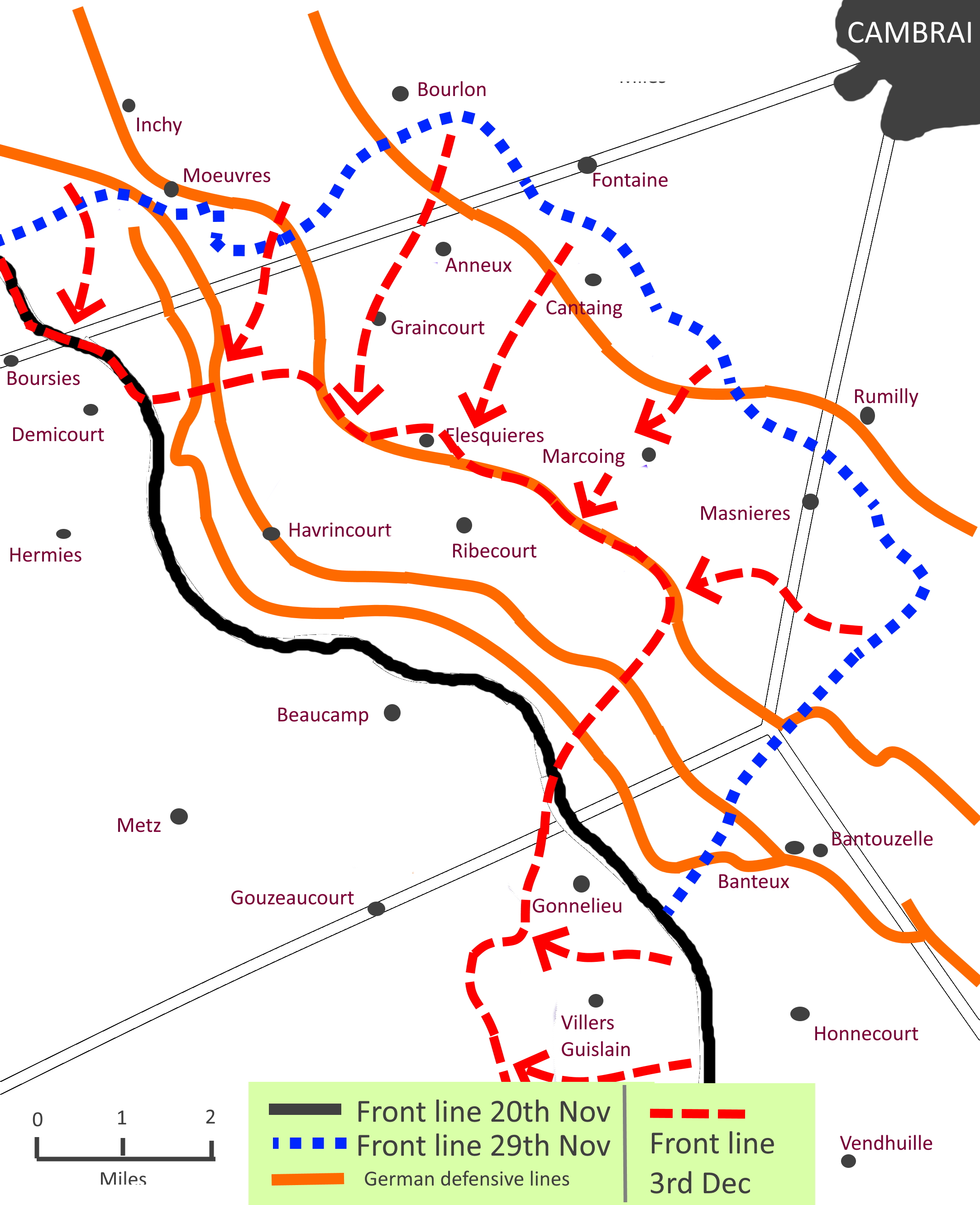
Map 3: The German counter-attacks in the Battle of the Cambrai (click for full size). The fact that the land over which the 7th East Surreys fought was so quickly re-taken by the Germans in further battles might explain why the bodies of those who died were never found after the war.
Reginald Sanderson was wounded on the 20th November 1917, with a severe gun shot wound to the hand and chest. Reginald's service record details that his chest injury was superficial but his hand was severely injured. The bullet entered his wrist on the ulnar (little finger) side and made its exit on the radial (thumb) side. It fractured a number of bones in his wrist. Reginald was evacuated from the battlefield but the records of his trip back to the UK have not directly survived, so we can only reconstruct what is likely to have happened to him, from records of the Assistant Director of Medical Services of the 12th Division. After injury Reginald would either have made his way to the Battalion Aid Post (if he could walk) or would have been picked up by his men, or stretcher bearers, and taken to the aid post. From there he would have been assessed and past back to the Advanced Dressing Station (ADS) at Viller Guislain, which was part of 36 or 37 Field Ambulance (a unit not an vehicle). Part of this journey may have been made by wheeled stretcher. From the ADS Reginald would have been transferred to the Casualty Clearing Station (CCS) by the Decauville Railroad or by motor ambulance. The CCS involved was either 2CCS or 5CCS and was at Tincourt. From the CCS Reginald was transferred to a General or Stationary Base Hospital, in his case at Le Havre, his journey probably being via Ambulance Train. Eventually, on the 26th November, 6 days after his injury, Reginald was embarked on a ship in Le Havre and travelled to Southampton where he disembarked on the 27th. Reginald attended several Medical Boards at the 3rd Southern General Hospital in Oxford to determine his treatment. His wrist injury was severe and on the 6th December the board heard that his hand wound had also become septic. This required his wound to be surgically reopened on two occasions to allow it to drain, but eventually infection was controlled and his wounds healed. However the bones in Reginald's wrist became fused together resulting in a permanent disability in his wrist, and he was eventually invalided out of the Army being awarded a Silver War Badge on the 10th April 1918.
After the war
After the First World War, Reginald went to Christ Church College, Oxford as a Kitchener Scholar. At Christ Church he played in the rugby XV, the Nondescripts and the Warrigals (cricket) and was a member of both the Cardinal and Mermaid Clubs. After Oxford, he joined the Civil Service and became the Deputy Chief Inspector of Labour for Gold Coast (now Ghana). Between 1921 and 1940, Reginald made numerous trips back and forth to Gold Coast, nearly always sailing from Liverpool to the twin cities of Sekondi and Takoradi, in Gold Coast.
In 1925, the Gold Coast Review published an article by him "The History of Nzima up to 1874."
Between 1923 and the Second World War Reginald made nine trips back to the UK, usually staying for between 14 and 24 weeks and on each occasion Reginald gave his address in the UK as Fairlea, Collingham - his parents' address.
| Date of Arrival | Port of Departure | Port of Arrival | Ship | Date of Departure | Port of Departure | Port of Arrival | Ship |
| 14 May 1923 | Sekondi | Liverpool | Aba | 3 Oct 1923 | Liverpool | Sekondi | Appam |
| 21 May 1925 | Sekondi | Liverpool | Aba | 16 Sep 1925 | Liverpool | Skondi | Aba |
| Apr 1927 | Sekondi | Liverpool | Appam | 7 Sep 1927 | Liverpool | Sekondi | Appam |
| 2 Nov 1928 | Sekondi | Plymouth | Accra | 13 Feb 1929 | Liverpool | Takoradi | Apapa |
| 22 Jun 1930 | Takoradi | Plymouth | Abirisi | 8 Oct 1930 | Liverpool | Takoradi | Accra |
| 14 May 1932 | Takoradi | Plymouth | Accra | 21 Sep 1932 | Liverpool | Takoradi | Accra |
| Apr 1934 | Takoradi | Plymouth | Appam | 10 Oct 1934 | Liverpool | Takoradi | Aba |
| 9 May 1936 | Takoradi | Plymouth | Abosso | 28 Oct 1936 | Liverpool | Takoradi | Abosso |
| 21 May 1938 | Takoradi | Plymouth | Abosso | 28 Sep 1938 | Liverpool | Takoradi | Accra |
Reginald returned again from Takoradi to Liverpool on the 18th May 1940 on the Abosso. After his leave, he again boarded the passenger liner Accra, on the 23rd July 1940, at Liverpool. The war was now on and Reginald would have known of the dangers of U-boats and that this would be no ordinary voyage. Accra joined convoy OB-188 of 37 ships carrying passengers and general cargoes for Freetown and other West African ports. Accra herself, owned by the Elder Dempster Line was carrying over 300 passengers and general cargo.
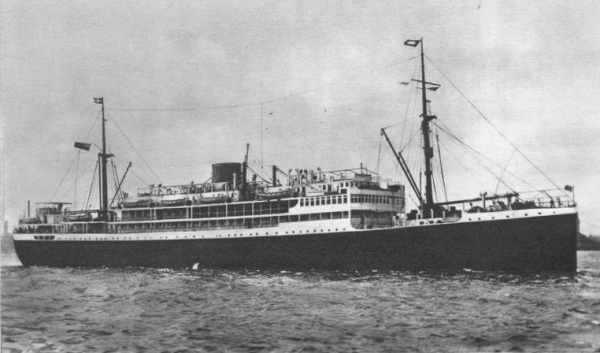
The Accra (courtesy of the Allen Collection).
On July 26th, the day before the Convoy was to disperse, the Accra was torpedoed by U-34 under the command of Korvettenkapitan Wilhelm Rollman in the Atlantic, about 300 miles west of Ireland, 320 miles West of Bloody Foreland. Accra was hit by one of three torpedoes fired by the U-boat and sank within ½ and 1½ hour in position 55' 40N 16' 28W. The Accra's Captain,(Master John Joseph Smith), 153 crew and 311 passengers were rescued by various ships - Hollinside (215 survivors) (British), the Loke (126 survivors)(Norwegian), 27 crew members and 52 passengers by the sloop HMS Enchantress (L 56) (Cdr A.K. Scott-Moncrieff, RN) and 45 survivors by the corvette HMS Clarkia (K 88) (LtCdr F.J.G. Jones, RNR). All the lifeboats had been successfully launched but eleven passengers and eight crew were lost when one lifeboat capsized in rough seas. Reginald Sanderson was one of those who lost their lives.
The sinking of the Accra was widely reported:
It was revealed yesterday that the Accra, a 9,337-ton Elder Dempster passenger liner, was sunk off the west coast of Eire in a submarine attack on a convoy on July 26.
Over 450 survivors have been landed at a North-West English port, and 19 persons, including 11 passengers, are reported missing. It is learned authoritatively that there were no children on board the liner.
The liner sank in about half an hour with colours flying. The rescue work had then been completed, and most of the loss of life occurred when a motor-boat overturned in the choppy sea. Some of the survivors were in lifeboats for hours.
Captain John Joseph Smith, of Gerard Road, Wallasay, said yesterday that the officers and crew of the Accra displayed great courage and coolness after the explosion and during the rescue operations.
CREW'S CALMNESS
"I hope I have the same crew when next I sail," he said. "If Hitler thinks he is going to win the war against men like this he had better think again. The officers and crew might have been queueing up the passengers for a cinema show or to go down a gangway at the landing stage, so quietly and coolly did they go about the work of marshalling those on board."
Captain Smith added that the Accra's passengers were having luncheon when the torpedo explosion occurred, and filed out of the saloon in orderly fashion. There was an abundance of room in the lifeboats.
He paid tribute to the cool gallantry of a 16-year-old bell-boy, who lined up passengers for the boats.
The men in the lifeboats sang "There will always be an England" when on the way to the rescuing ships, and the whole of the rescue work was completed in half an hour.
A steward, Herbert Enright, of Coventry, who was making his fourth trip in the Accra, was torpedoed in the Yorkshire and was picked up by another ship, which was also torpedoed. In the last war he was torpedoed in the Lusitania, and after that joined the Army and was captured by the Germans.
He said that one of the engineers was blown along the propeller tunnel by the explosion, but managed to get back to the motor room, and in spite of his injuries this engineer helped to lower the motor-lifeboat.
A.B. Edward Long, of Dingle, Liverpool, a lamp-trimmer of the Accra, said he was up the mast when the vessel was struck by a torpedo, and as he was coming down another explosion occurred which nearly threw him to the deck. He paid tribute to Chief Officer Thompson, who showed great coolness and resource when he went round to every boat to make sure that it was provisioned and that those on board were comfortable.
The Accra was one of the largest of the Elder Dempster ships and was launched from Belfast in 1926. She was a fast and popular vessel on the West African route.
An old boy of Leeds Grammar School, returning to the Gold Coast, is believed to be among passengers lost in the sinking of the Accra, the liner sunk off the west coast of Eire in a submarine attack on a convoy.
He is Mr. Reginald Woolley Sanderson, Deputy Chief Inspector of Labour in the Gold Coast Colony.
Mr. Sanderson's home was at Fairlea, Collingham, where his sister, Miss I.C. Sanderson, has received news that her brother "is not included in the list of those whose safety has been established."
Miss Sanderson informed a "Yorkshire Evening Post" reporter today that her brother had been on leave, and was returning on the Accra to the Gold Coast. He is a single man, aged 43.
After the sinking of the Accra, 450 survivors were landed at an English port. Nineteen persons, including 11 passengers, were reported missing.
Mr. Reginald Sanderson is the son of Mrs. Sanderson and the late Henry Sanderson, of Collingham, and grandson of the late Mr. Jabez Wooley, of Garforth.
Educated at Leeds Grammar School and Christ Church, Oxford, he entered the Civil Service and went to the Gold Coast 17 years ago as Assistant Commissioner. Later he became District Commissioner and then Deputy Chief Inspector of Labour.
Mr. Sanderson served in the Great War in the Artists Rifles and East Surrey Regiment, and was disabled and invalided out of the Service in April 1918.
U-34 also sank the Vinemmor, another of the ships of Convoy OB-188 on the same day, and Sambre and Thiara south west of Rockall, the following day after they had dispersed from the same convoy, OB-188.
Reginald Woolley Sanderson lost his life at sea, however an inscription on his parents' grave in Collingham churchyard states:
"Also REGINALD WOOLLEY SANDERSON beloved son of Henry and Edith Sanderson lost at sea July 1940 due to enemy action, found later and laid to rest at Dungloe Eire".
Obviously Reginald's body was found later and was buried at Dungloe which is in Donegal on the west coast of Ireland.
Biography last updated 25 March 2022 15:44:09.
Sources
1911 Census. The National Archives. Class RG14 Piece 26965
First World War Medal Index Cards. The National Archives (WO372).
First World War Medal Index Rolls. The National Archives (WO329).
First World War Officer's Service Records WO374/60290 The National Archives.
War Diary of 7th Battalion East Surrey Regiment (WO95/1862) The National Archives.
Commonwealth War Graves Commission Cemetery and Burial Reports
If you have any photographs or further details about this person we would be pleased to hear from you. Please contact us via: alan.berry@collinghamanddistrictwararchive.info